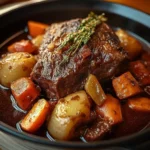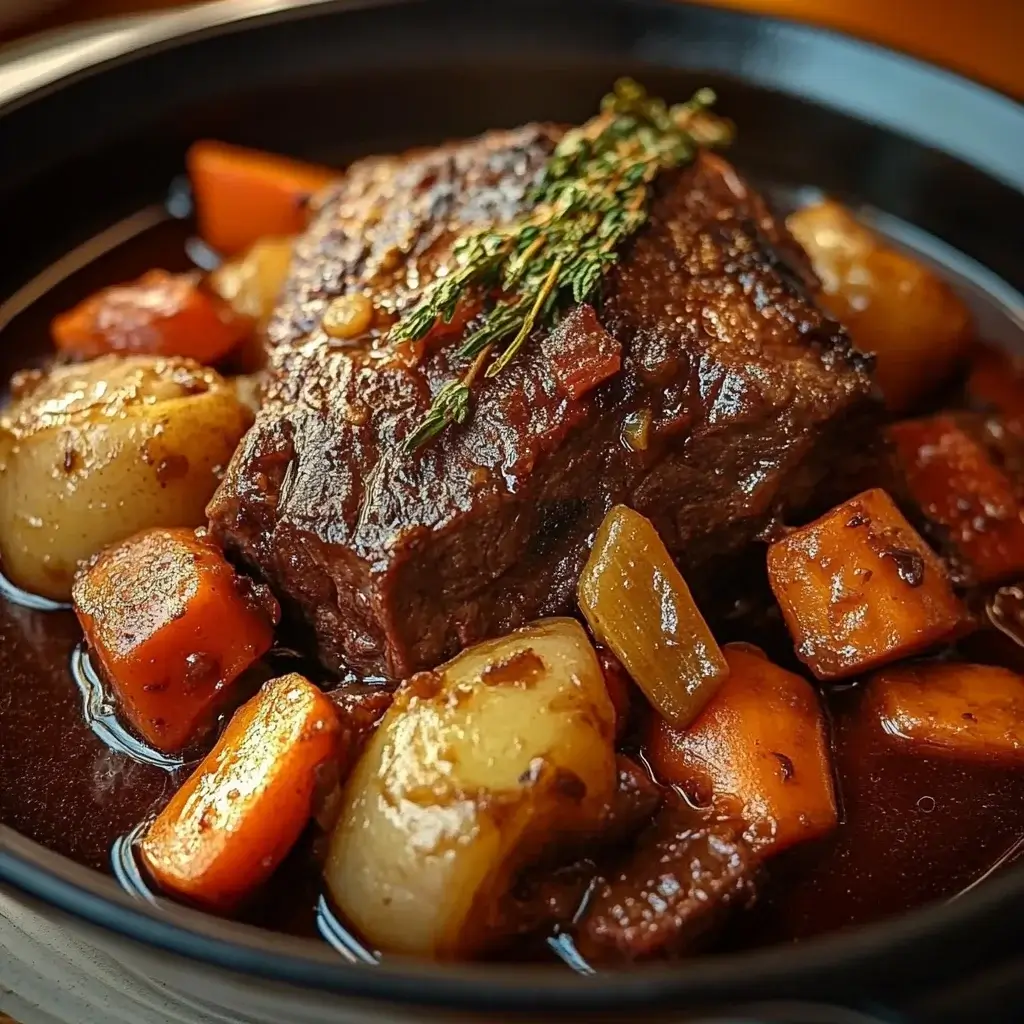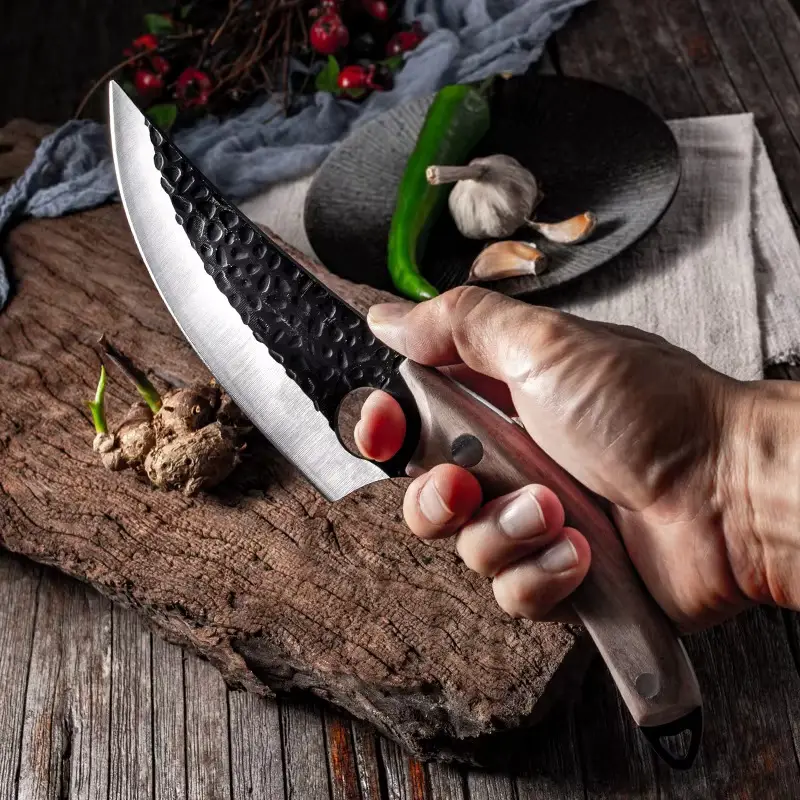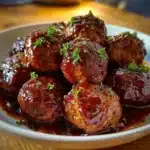My family absolutely adores pot roast night, and this Dutch Oven Pot Roast with Vegetables recipe has become a true star in our rotation. There’s something undeniably comforting about the aroma that fills the house as it slowly braises, promising a hearty and deeply flavorful meal. What I love most is how effortlessly the Dutch oven transforms humble ingredients into a culinary masterpiece. The beef becomes incredibly tender, practically melting in your mouth, and the vegetables are infused with the rich, savory broth. Even my pickiest eater happily devours the carrots and potatoes when they’ve been cooked this way! This recipe is not just dinner; it’s an experience, a gathering around a table filled with warmth and deliciousness. It’s the kind of meal that makes everyone feel loved and satisfied, and it’s become a cherished tradition in our home.
Ingredients
- Beef Chuck Roast (3-4 lbs): The star of the show, chuck roast is perfect for braising, becoming incredibly tender as it cooks. Look for a well-marbled roast for maximum flavor and moisture.
- Olive Oil (2 tbsp): Used for searing the roast and sautéing vegetables, adding flavor and preventing sticking.
- Yellow Onion (1 large, chopped): Forms the aromatic base of the dish, adding sweetness and depth of flavor to the broth.
- Carrots (1 lb, peeled and chopped): Adds sweetness, color, and nutritional value. Choose full-sized carrots, or baby carrots for convenience.
- Celery (3 stalks, chopped): Provides an earthy, savory note and aromatic complexity to the pot roast.
- Potatoes (1.5 lbs, Yukon Gold or Russet, quartered): Yukon Golds hold their shape well during braising and provide a creamy texture. Russets become fluffier and absorb the broth beautifully.
- Garlic (4 cloves, minced): Infuses the dish with pungent, savory flavor. Freshly minced garlic is always best.
- Beef Broth (4 cups): The braising liquid, adding richness and beefy flavor. Low sodium broth allows you to control the salt level.
- Dry Red Wine (1 cup, optional): Adds depth, complexity, and acidity to the sauce. Use a dry red wine like Cabernet Sauvignon, Merlot, or Pinot Noir. Can be substituted with more beef broth.
- Worcestershire Sauce (2 tbsp): Enhances the savory flavors of the beef and broth with its umami richness.
- Tomato Paste (2 tbsp): Adds depth of flavor, richness, and a subtle sweetness to the sauce.
- Dried Thyme (1 tsp): Provides a warm, earthy, and slightly minty flavor that complements beef and vegetables.
- Dried Rosemary (1 tsp): Offers a piney, aromatic, and slightly peppery flavor that pairs wonderfully with beef.
- Bay Leaf (1-2 leaves): Infuses a subtle, tea-like aroma and depth to the braising liquid. Remember to remove before serving.
- Salt and Black Pepper: To taste, essential for seasoning and enhancing all the flavors in the dish.
- Fresh Parsley (for garnish, chopped): Adds freshness and a pop of color when serving.
Instructions
- Prepare the Roast: Pat the chuck roast dry with paper towels. Season generously on all sides with salt and freshly ground black pepper. Drying the roast helps achieve a better sear.
- Sear the Roast: Heat olive oil in a large Dutch oven over medium-high heat until shimmering. Carefully place the roast in the hot Dutch oven and sear on all sides until deeply browned, about 3-4 minutes per side. Searing creates a flavorful crust and seals in the juices. Remove the roast from the Dutch oven and set aside.
- Sauté Aromatics: Reduce the heat to medium. Add chopped onion, carrots, and celery to the Dutch oven. Cook, stirring occasionally, until the vegetables begin to soften and the onions become translucent, about 5-7 minutes. Sautéing the vegetables releases their flavors and creates a flavorful base for the pot roast.
- Add Garlic and Tomato Paste: Add minced garlic and tomato paste to the vegetables in the Dutch oven. Cook, stirring constantly, for about 1 minute, until fragrant and the tomato paste darkens slightly. This step blooms the tomato paste and garlic, intensifying their flavors.
- Deglaze the Pot (Optional but Recommended): If using red wine, pour it into the Dutch oven, scraping up any browned bits from the bottom of the pot with a wooden spoon. This process, called deglazing, adds depth of flavor to the sauce. Cook for 1-2 minutes, allowing the wine to reduce slightly. If not using wine, skip this step and proceed directly to adding broth.
- Add Broth and Seasonings: Pour beef broth into the Dutch oven. Add Worcestershire sauce, dried thyme, dried rosemary, and bay leaf. Stir to combine all the ingredients.
- Return Roast to Dutch Oven: Return the seared chuck roast to the Dutch oven, nestling it into the vegetables and broth. The liquid should come about halfway up the sides of the roast. If needed, add a little more beef broth to reach this level.
- Braise in the Oven: Bring the liquid to a simmer on the stovetop. Then, cover the Dutch oven with its lid and transfer it to a preheated oven at 325°F (160°C). Braise for 3-4 hours, or until the roast is fork-tender and easily shreds apart. The long, slow braising process is what makes the roast incredibly tender. Check for tenderness after 3 hours; cooking time can vary depending on the size and cut of the roast.
- Add Potatoes (and Adjust Vegetables if Needed): After 2 hours of braising (or when the roast is almost tender), add quartered potatoes to the Dutch oven. If you prefer your carrots and celery softer, you can add additional carrots and celery at this stage as well. Adding the potatoes later prevents them from becoming mushy.
- Continue Braising: Continue to braise, covered, for another 1-1.5 hours, or until the potatoes are tender and cooked through, and the roast is completely fork-tender.
- Rest and Shred the Roast: Once the roast is cooked, carefully remove the Dutch oven from the oven. Remove the roast from the Dutch oven and place it on a cutting board. Let it rest for 10-15 minutes before shredding it with two forks. Resting allows the juices to redistribute throughout the meat, resulting in a more tender and flavorful roast.
- Skim Fat and Thicken Gravy (Optional): While the roast is resting, skim off any excess fat from the surface of the braising liquid in the Dutch oven. If you want a thicker gravy, you can create a slurry by whisking together 1-2 tablespoons of cornstarch or all-purpose flour with 2-3 tablespoons of cold water. Gradually whisk the slurry into the braising liquid in the Dutch oven. Bring to a simmer over medium heat on the stovetop and cook, stirring constantly, until the gravy thickens to your desired consistency, about 2-3 minutes.
- Serve: Return the shredded roast to the Dutch oven with the vegetables and gravy. Stir gently to combine. Garnish with fresh parsley. Serve hot and enjoy!
Nutrition Facts
(Per serving, estimated, based on 6 servings. Nutritional values can vary based on specific ingredients and serving sizes)
- Servings: 6
- Calories: Approximately 550-650 kcal
- Protein: 45-55g
Note: These values are estimates and should be considered as a general guideline. For precise nutritional information, use a nutrition calculator with the specific brands and quantities of ingredients used.
Preparation Time
- Prep Time: 30 minutes (chopping vegetables, searing roast)
- Cook Time: 4-5 hours (braising time, including vegetable cooking)
- Total Time: 4.5 – 5.5 hours
This Dutch Oven Pot Roast requires a longer cooking time due to the slow braising process, which is essential for developing deep flavors and tenderizing the beef. While the active prep time is relatively short, plan ahead to allow for the extended braising time to achieve the best results.
How to Serve
Dutch Oven Pot Roast with Vegetables is a complete meal in itself, but here are some delicious ways to serve it and enhance your dining experience:
- Classic Plating:
- Spoon generous portions of shredded pot roast, vegetables, and gravy onto plates.
- Garnish with fresh parsley for a pop of color and freshness.
- Serve with a side of crusty bread or dinner rolls for soaking up the delicious gravy.
- Over Mashed Potatoes:
- Create a bed of creamy mashed potatoes on each plate.
- Top with a heaping serving of pot roast, vegetables, and gravy.
- The mashed potatoes provide a comforting and absorbent base for the rich flavors.
- With Egg Noodles or Wide Noodles:
- Serve the pot roast and vegetables over cooked egg noodles or wide noodles.
- The noodles soak up the gravy beautifully, creating a hearty and satisfying meal.
- As Sandwiches or Sliders (Leftovers):
- Shred leftover pot roast and pile it onto toasted buns or slider rolls.
- Top with a spoonful of the braising liquid or gravy for extra moisture.
- Add a slice of provolone cheese or caramelized onions for added flavor.
- Alongside a Green Salad:
- Balance the richness of the pot roast with a fresh and vibrant green salad.
- A simple vinaigrette dressing complements the savory flavors of the main dish.
- With Creamy Polenta:
- Serve the pot roast over a bed of creamy polenta.
- The smooth texture of polenta provides a delightful contrast to the tender roast and vegetables.
- Family Style on a Platter:
- Arrange the shredded pot roast and vegetables attractively on a large platter.
- Drizzle generously with gravy and garnish with parsley.
- Let everyone serve themselves at the table for a communal and inviting meal.
Additional Tips for the Best Dutch Oven Pot Roast
- Choose the Right Cut of Beef: Chuck roast is the classic choice for pot roast because it has good marbling and connective tissue that breaks down during long, slow braising, resulting in incredibly tender and flavorful meat. Other suitable cuts include brisket or round roast.
- Don’t Skip the Searing: Searing the chuck roast before braising is crucial for developing deep, rich flavor. It creates a flavorful crust on the meat through the Maillard reaction, which enhances the overall taste of the pot roast.
- Season Generously: Don’t be shy with salt and pepper! Season the roast generously before searing and season the vegetables and broth as well. Proper seasoning is key to bringing out the best flavors of all the ingredients.
- Use Quality Broth: The beef broth forms the base of the braising liquid and significantly impacts the flavor of the pot roast. Opt for a good quality beef broth or even homemade broth for the best results. Low sodium broth is recommended so you can control the salt level.
- Don’t Overcrowd the Dutch Oven: Ensure there’s enough space in the Dutch oven for the roast and vegetables to braise properly. Overcrowding can steam the ingredients instead of braising them, hindering browning and flavor development. If necessary, use a larger Dutch oven or cook in batches.
- Braise Low and Slow: Low and slow braising is the key to tender pot roast. Maintain a consistent oven temperature of 325°F (160°C) and allow ample time for the roast to become fork-tender. Rushing the process can result in tough meat.
- Adjust Vegetables to Your Preference: You can customize the vegetables based on your preferences and what you have on hand. Other great additions or substitutions include parsnips, turnips, sweet potatoes, or mushrooms. Add heartier vegetables like potatoes and carrots earlier, and more delicate vegetables like mushrooms later in the cooking process.
- Make Ahead and Reheat (Even Better the Next Day!): Pot roast is an excellent make-ahead meal. In fact, it often tastes even better the next day as the flavors have had more time to meld together. Store leftover pot roast in the refrigerator in an airtight container for up to 3-4 days. Reheat gently on the stovetop or in the oven until heated through.
FAQ About Dutch Oven Pot Roast
Q1: Can I make pot roast in a slow cooker instead of a Dutch oven?
A: Yes, you can adapt this recipe for a slow cooker. Sear the roast in a skillet as instructed, then transfer it to the slow cooker along with the vegetables, broth, and seasonings. Cook on low for 6-8 hours or on high for 3-4 hours, or until the roast is fork-tender. Slow cookers often retain more moisture, so you may not need to add as much broth, and the gravy might be thinner. You can thicken it at the end if desired.
Q2: What if I don’t have red wine? Can I still make pot roast?
A: Absolutely! Red wine adds depth and complexity, but it’s not essential. Simply substitute the red wine with an equal amount of beef broth. You can also add a splash of balsamic vinegar or red wine vinegar for a touch of acidity if you like.
Q3: Can I use different vegetables in my pot roast?
A: Yes, feel free to customize the vegetables based on your preferences and what’s in season. Good alternatives or additions include parsnips, turnips, rutabaga, sweet potatoes, butternut squash, mushrooms, or even green beans added towards the end of cooking.
Q4: How do I know when the pot roast is done?
A: The pot roast is done when it is fork-tender. This means you should be able to easily pierce the meat with a fork and it should shred apart with minimal effort. The internal temperature should reach around 200-205°F (93-96°C), as this is when the connective tissue breaks down and the meat becomes incredibly tender.
Q5: My gravy is too thin. How can I thicken it?
A: There are several ways to thicken pot roast gravy. The easiest is to make a cornstarch or flour slurry (as described in the instructions). Alternatively, you can remove some of the vegetables and broth from the Dutch oven and blend them in a blender or with an immersion blender until smooth, then return the blended mixture to the pot. Simmering the gravy uncovered for a while can also help reduce and thicken it naturally.
Q6: Can I use baby carrots instead of regular carrots?
A: Yes, baby carrots are perfectly fine to use for convenience. You can use the same weight of baby carrots as you would regular carrots. They may cook a bit faster, so keep an eye on them to prevent them from becoming too soft.
Q7: Can I freeze leftover pot roast?
A: Yes, leftover pot roast freezes well. Allow the pot roast to cool completely, then transfer it to freezer-safe containers or freezer bags. Freeze for up to 2-3 months. Thaw overnight in the refrigerator before reheating.
Q8: What kind of potatoes are best for pot roast?
A: Yukon Gold potatoes are a great choice for pot roast because they hold their shape well during braising and have a creamy texture. Russet potatoes are also a good option if you prefer a fluffier potato that absorbs the broth beautifully. Red potatoes are another good choice that holds its shape well. Avoid waxy potatoes like fingerling or new potatoes, as they can become too firm in pot roast.
Print
Dutch Oven Pot Roast with Vegetables
Ingredients
- Beef Chuck Roast (3-4 lbs): The star of the show, chuck roast is perfect for braising, becoming incredibly tender as it cooks. Look for a well-marbled roast for maximum flavor and moisture.
- Olive Oil (2 tbsp): Used for searing the roast and sautéing vegetables, adding flavor and preventing sticking.
- Yellow Onion (1 large, chopped): Forms the aromatic base of the dish, adding sweetness and depth of flavor to the broth.
- Carrots (1 lb, peeled and chopped): Adds sweetness, color, and nutritional value. Choose full-sized carrots, or baby carrots for convenience.
- Celery (3 stalks, chopped): Provides an earthy, savory note and aromatic complexity to the pot roast.
- Potatoes (1.5 lbs, Yukon Gold or Russet, quartered): Yukon Golds hold their shape well during braising and provide a creamy texture. Russets become fluffier and absorb the broth beautifully.
- Garlic (4 cloves, minced): Infuses the dish with pungent, savory flavor. Freshly minced garlic is always best.
- Beef Broth (4 cups): The braising liquid, adding richness and beefy flavor. Low sodium broth allows you to control the salt level.
- Dry Red Wine (1 cup, optional): Adds depth, complexity, and acidity to the sauce. Use a dry red wine like Cabernet Sauvignon, Merlot, or Pinot Noir. Can be substituted with more beef broth.
- Worcestershire Sauce (2 tbsp): Enhances the savory flavors of the beef and broth with its umami richness.
- Tomato Paste (2 tbsp): Adds depth of flavor, richness, and a subtle sweetness to the sauce.
- Dried Thyme (1 tsp): Provides a warm, earthy, and slightly minty flavor that complements beef and vegetables.
- Dried Rosemary (1 tsp): Offers a piney, aromatic, and slightly peppery flavor that pairs wonderfully with beef.
- Bay Leaf (1-2 leaves): Infuses a subtle, tea-like aroma and depth to the braising liquid. Remember to remove before serving.
- Salt and Black Pepper: To taste, essential for seasoning and enhancing all the flavors in the dish.
- Fresh Parsley (for garnish, chopped): Adds freshness and a pop of color when serving.
Instructions
- Prepare the Roast: Pat the chuck roast dry with paper towels. Season generously on all sides with salt and freshly ground black pepper. Drying the roast helps achieve a better sear.
- Sear the Roast: Heat olive oil in a large Dutch oven over medium-high heat until shimmering. Carefully place the roast in the hot Dutch oven and sear on all sides until deeply browned, about 3-4 minutes per side. Searing creates a flavorful crust and seals in the juices. Remove the roast from the Dutch oven and set aside.
- Sauté Aromatics: Reduce the heat to medium. Add chopped onion, carrots, and celery to the Dutch oven. Cook, stirring occasionally, until the vegetables begin to soften and the onions become translucent, about 5-7 minutes. Sautéing the vegetables releases their flavors and creates a flavorful base for the pot roast.
- Add Garlic and Tomato Paste: Add minced garlic and tomato paste to the vegetables in the Dutch oven. Cook, stirring constantly, for about 1 minute, until fragrant and the tomato paste darkens slightly. This step blooms the tomato paste and garlic, intensifying their flavors.
- Deglaze the Pot (Optional but Recommended): If using red wine, pour it into the Dutch oven, scraping up any browned bits from the bottom of the pot with a wooden spoon. This process, called deglazing, adds depth of flavor to the sauce. Cook for 1-2 minutes, allowing the wine to reduce slightly. If not using wine, skip this step and proceed directly to adding broth.
- Add Broth and Seasonings: Pour beef broth into the Dutch oven. Add Worcestershire sauce, dried thyme, dried rosemary, and bay leaf. Stir to combine all the ingredients.
- Return Roast to Dutch Oven: Return the seared chuck roast to the Dutch oven, nestling it into the vegetables and broth. The liquid should come about halfway up the sides of the roast. If needed, add a little more beef broth to reach this level.
- Braise in the Oven: Bring the liquid to a simmer on the stovetop. Then, cover the Dutch oven with its lid and transfer it to a preheated oven at 325°F (160°C). Braise for 3-4 hours, or until the roast is fork-tender and easily shreds apart. The long, slow braising process is what makes the roast incredibly tender. Check for tenderness after 3 hours; cooking time can vary depending on the size and cut of the roast.
- Add Potatoes (and Adjust Vegetables if Needed): After 2 hours of braising (or when the roast is almost tender), add quartered potatoes to the Dutch oven. If you prefer your carrots and celery softer, you can add additional carrots and celery at this stage as well. Adding the potatoes later prevents them from becoming mushy.
- Continue Braising: Continue to braise, covered, for another 1-1.5 hours, or until the potatoes are tender and cooked through, and the roast is completely fork-tender.
- Rest and Shred the Roast: Once the roast is cooked, carefully remove the Dutch oven from the oven. Remove the roast from the Dutch oven and place it on a cutting board. Let it rest for 10-15 minutes before shredding it with two forks. Resting allows the juices to redistribute throughout the meat, resulting in a more tender and flavorful roast.
- Skim Fat and Thicken Gravy (Optional): While the roast is resting, skim off any excess fat from the surface of the braising liquid in the Dutch oven. If you want a thicker gravy, you can create a slurry by whisking together 1-2 tablespoons of cornstarch or all-purpose flour with 2-3 tablespoons of cold water. Gradually whisk the slurry into the braising liquid in the Dutch oven. Bring to a simmer over medium heat on the stovetop and cook, stirring constantly, until the gravy thickens to your desired consistency, about 2-3 minutes.
- Serve: Return the shredded roast to the Dutch oven with the vegetables and gravy. Stir gently to combine. Garnish with fresh parsley. Serve hot and enjoy!
Nutrition
- Serving Size: one normal portion
- Calories: 650
- Protein: 55g






